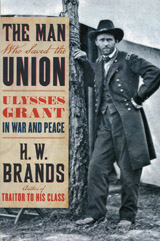
Ulysses S. Grant has had his ups and downs in the halls of history. Though he was hailed as the conquering hero after Appomattox, by late century his stature was chipped away by the promoters of the Lost Cause. In this exercise, paladin Robert E. Lee was only defeated by overwhelming numbers wielded by Grant the butcher. The scandals of Grant’s two-term presidency added to the tarnish.
In 1929 Grant’s generalship was praised by the British theoretician J. F. C. Fuller, but still the dull commoner-as-general image persisted…and it was said the man drank. In the 1960s Grant at last found his biographer in Bruce Catton, whose two volumes—Grant Moves South (1960) and Grant Takes Command (1968)—set the standard for the study of Grant the general.
In 1981, however, the general’s reputation took another dip in William S. McFeely’s Grant: A Biography. McFeely’s effort covered a full life, won prizes, and painted the general as unfeeling of human life and the president as indifferent to the aspirations of the former slaves.
Then an uptick. Brooks D. Simpson led a telling attack on McFeely’s reading of Grant and in 2000 published his own biography, Ulysses S. Grant: Triumph over Adversity, 1822–1865. Simpson utilized the comprehensive Papers of Ulysses S. Grant, and his life of soldier Grant is wide ranging and analytical.
H. W. Brands, veteran historian and biographer, embarked on a U.S. history in six volumes, each with a chief figure—Benjamin Franklin, Andrew Jackson, the two Roosevelts. Ulysses Grant in War and Peace is his choice for the Civil War and Reconstruction. It might best be classified as U. S. Grant 101.
After West Point, quartermaster Grant tasted battle in the Mexican War and discovered “that he never functioned better than when under fire,” writes Brands. “Others became rattled and confused; he grew calm and focused.” In 1854 Grant left the army at lonely Fort Humboldt in California under threat of court-martial for allegedly being drunk on duty, and spent the rest of the decade in a faltering attempt to support his growing family. The Civil War found Grant, and Grant found his vocation.
Brands chronicles Grant from colonel of the 21st Illinois to lieutenant general of the U.S. Army largely by means of Grant’s Personal Memoirs. This work is justly famous, but the story of his spectacular rise thereby remains more under Grant’s control than Brands’s. There is consequently a lack of critical analysis, especially in Grant’s often complex relationship with the Lincoln administration, and little explication of just what Grant possessed that was so lacking in other Civil War generals.
Grant’s post-Appomattox years consume as much space as the war years. Brands wryly notes that Grant’s Memoirs merit their distinction “in part by avoiding the presidency,” so he broadens his search and finds praise in Grant’s two terms. He points to his unappreciated efforts against the Ku Klux Klan and for racial peace, and his attention to the intractable problem of the western Indians. For the student of Grant’s military career Bruce Catton and Brooks Simpson remain the best guides. For an overall look at Grant’s posting in the age of war and Reconstruction, H. W. Brands will do nicely.
MHQ contributing editor Stephen W. Sears has written and edited many books about the Civil War, including The Civil War: The Second Year Told by Those Who Lived It (Library of America, 2012).





